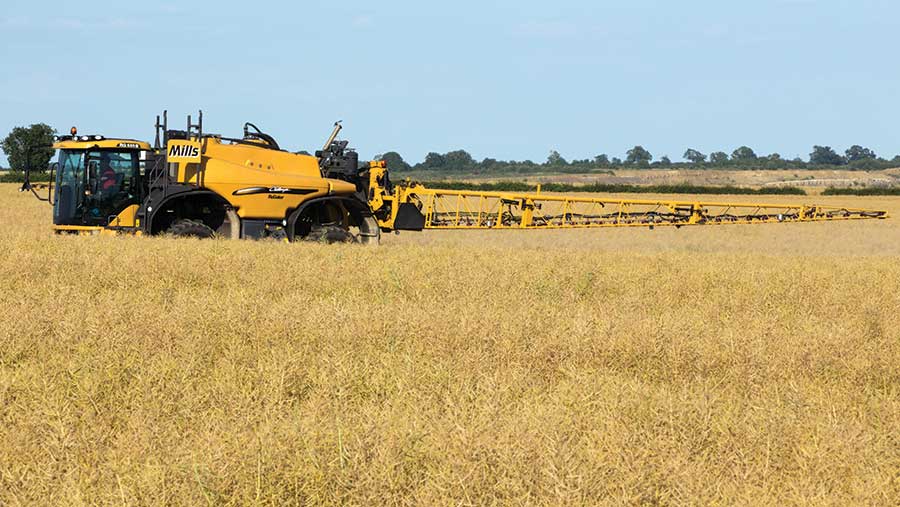Crop Watch: Learning disease lessons as harvest kicks off
 © Tim Scrivener
© Tim Scrivener Harvest has already arrived for some winter barley crops on light land and our agronomists are looking at the lessons for next season.
One factor that our agronomist agree on is the increasing importance of wheat varieties’ resistance to diseases. This season, the dry weather has helped avoid what was looking like a high-pressure year, testing even robust fungicide programmes.
This is illustrated by susceptible varieties such as Cordiale displaying high levels of septoria, even with a solid fungicide programme.

marion self
East: Marion Self
Prime Agriculture (Suffolk)
What a season. It started late and seems set to finish early as the first crops of winter barley are already harvested. Oilseed rape desiccation is under way and the countdown to cutting has begun.
Wheats are stressed, with some crops senescing quickly in the extreme heat and dry conditions. Crops on heavier land that have caught the odd shower in June remain green, although, given the forecast of another dry week, growers are anxiously watching the yield potential slip.
Looking at wheat fungicide and variety trials over the past few days, it is apparent that septoria levels are moderate, with crops showing treatment differences according to programme strategies and the level of inputs.
Without the relatively dry May and June to check it, septoria pressure would be high, even testing the most robust programmes.
See also: How one OSR grower is benefitting from companion crops
Rusts are apparent in susceptible varieties, although most treatments are holding the infection. Viewing plots now sharpens our focus on the choice of wheat varieties and the need to consider those with good disease ratings. Think back 12 months and don’t forget lodging risk too.
Treatments on late-drilled spring cereals are now complete; yield potential of these will be variable. Agronomy on the spring pulses is also being completed except for some late-drilled crops of vining peas where aphids are proving a challenge.
Caught up
Sugar beet growth has now caught up after the late start to drilling. Foliar nutrition has been applied and our thoughts turn to disease control strategies.
Recently there has been a shift in the incidence of diseases other than powdery mildew and rust. Cercospora is now a regular threat alongside increased alternaria and stemphylium.
First sprays should be based on an azole and strobilurin applied from mid-July (the onset of foliar disease). Remember that current conditions favour powdery mildew, though.
Now is the time to reflect and refine plans for the autumn. Finalise your autumn cropping and plan your cultivation strategies.
Look where remedial action and attention to detail is required, in areas such as subsoiling, mole draining, ditching and drainage, and concentrate on encouraging blackgrass to chit.
Also think through harvest logistics to minimise grassweed transfer by combines, balers, muck and so on. I like a plan – it’s good to know where you’re heading – but be prepared to make a detour if required.

Mary Munro
North: Mary Munro
AICC/Strutt & Parker (Perthshire)
How much effect will the prolonged dry period have on yields? Crops are looking decidedly drought-stressed, and it stands to reason, as the winter crops are not particularly well rooted, having started life in wet seed-beds and covered in snow during the winter.
Winter barleys are ripening rapidly, and where they are growing on deeper soils, the grains look a reasonable size. However, there are plenty of poorer areas on lighter or shallower soil and these will pull the averages down.
Winter wheat is very variable, and the white heads of take-all are becoming apparent in second crops.
There are some good first wheats about though, and where the yield potential is reasonable, I have applied a robust head spray such as Amistar Opti (azoxystrobin + chlorothalonil) plus Proline (prothioconazole). This should help maintain green leaf a little longer.
Where crops have been on the back foot all season the head spray has been a two-way azole mix. There is a bit of mildew lurking low down on the stems, but septoria and rust have not had a chance to get going. It has been easy to keep to timings, with barely any wind or rain to stop the sprayers.
Spring barley
Spring barley is also struggling – most of it was sown in dry seed-beds, and germination and emergence was patchy, and very moisture-dependent. Disease pressure has been minimal.
Concerto is still the main malting variety, but Laureate is a far superior variety agronomically, with much better disease resistance and a significantly greater yield.
Protecting the flag leaf and awns is vital, particularly against ramularia. Siltra Xpro (bixafen + prothioconazole) plus chlorothalonil is my preferred choice this year.
There has been some debate at the various field events about crop protection strategies, and the threat of losing much of the current armoury of products.
While maximising output is the key to a good profit margin, I believe it is very important to use varietal disease resistance as part of the crop production plan, and to be willing to vary a programme depending on weather and disease pressure.
We may all have to pay more attention to these factors in future.

Richard Harding
South: Richard Harding
Procam (Sussex)
Here on the Downs, the first winter barley has been cut, with early indications that yields are holding up, despite the current high temperatures. Crops, especially those on the lighter soils, are beginning to look very ripe, and no doubt many are expecting to start combining from the beginning of next week.
“Flaming June” continued through the weekend, with more of the same forecast for the coming week. This has seen areas within fields of some winter cereal crops clearly showing drought stress.
Although higher temperatures will be moving crops along at an increasing rate, overall they look far more promising than expected, given the challenging spring.
Some oilseed rape crops that have already received a pod sealant will have been desiccated this week, and many will follow on early next week. Because of their height and stage of ripeness, some crops are likely to be combined without desiccation.
The heavy land wheats and spring cereals are holding on well, but on lighter soil types, the warm, dry conditions are taking their toll.
These conditions may shorten the grain-fill period, but this may be offset by higher sunlight levels and photosynthetic activity. Weather station data is currently showing 126 sunshine hours recorded in June, compared with 185 in total last year.
Varietal differences
Despite the prevailing dry conditions, some disease is still lurking. Cordiale, for example, is displaying high levels of septoria, even with a robust fungicide programme.
Other varieties, such as Graham and Siskin, on the same farm, have minimal infection from the same fungicide input. Not altogether surprising given Cordiale is rated 4.5 for Septoria tritici, with Graham and Siskin rated 6.9.
Aphid numbers seem to be broadly similar this week when compared with last, but this would be before the peak in daytime temperatures. The risk in cereals is now low, especially as crops mature, but some issues remain for potatoes and vegetables, with black bean aphid numbers increasing.
Bruchid beetle is becoming an issue in spring beans in these higher temperatures as pods begin to form, while pea moth numbers are at, or just below, threshold levels.
Last week saw the third year of the Groundswell event in Hertfordshire. An excellent event that saw more than 1,000 farmers from all over the world attending, some from as far away as Russia.
With such an inspiring range of speakers, I feel suitably motivated and ready for the imminent start to another season. It’s hugely pleasing to see the growing interest in soils and soil biology.

Antony Wade
West: Antony Wade
Hillhampton Technical Services (Herefordshire/Shropshire)
“Motoring May” has given way to “Flaming June”, with very little rainfall and above-average temperatures.
Earlier in the month these were not excessive – in the mid-20Cs, which was ideal for cereal crops, but in the past week these have crept up to the high 20Cs and the occasional day above 30C. At these temperatures we are starting to see crops suffer, with some leaf roll and patches starting to burn up.
So as I said in my last article, May was full of promise, but with high temperatures forecast to continue and no sign of rain after a very dry June, I fear July may be a month of potential evaporating in many wheat and spring cereal crops.
The high temperatures may have less of a detrimental effect on winter barley and oilseed rape crops, as they had generally already done their grain filling earlier in the month in the cooler temperatures, so yield potential is still looking reasonable.
However, it is very difficult to predict eventual yield for oilseed rape. Stem disease, including sclerotinia, looks to have been controlled well, although I have heard reports of verticillium wilt symptoms showing in some crops.
Green rapeseed
The hot weather is burning off the top of the crop, but I am still finding green seeds in pods on lower pods. However, the scorching-off of generally fairly even crops is calling into question the need for desiccation glyphosate.
Spring crops that were generally drilled late and have not had chance to get roots down as far as in a normal spring will surely soon start to show stress. It is noticeable at recent demonstrations that those crops following cover crops are holding on much better.
Maize is the only spring crop that will be enjoying the high temperatures. However, the dry conditions may yet have an effect on the establishment of undersown grasses for soil stabilisation. This gives further justification for the system where we can drill the grass at the same time as the maize crop.

